Azalea family at a glance
Azalea: Genus Rhododendron
Azalea belongs to the genus Rhododendron, which has about 1000 natural species. These species are further divided into 8 subgenera, according to the American Rhododendron Society. Most of them are native to southeast to eastern Asia (including Japan) through the Himalayan region but some are found in North America and Europe as well.
Azaleas (Rhododendrons) come in enormous diversity.
- Size: Ranging from small ground covers to tall trees over 100 feet
- Leaf sizes: Vary from less than 1/4 inch to almost three feet long
- Leaf shapes: Rounded, lance-shaped, and elliptical
- Flower colors: White, red, pink, yellow, blue(-ish), purple, magenta, orange, and mixtures of these colors
- Bark: Varied texture and color
- Flowering Time: Peak months in March, April, and May, but can vary from January to October depending on climate
They can also be either evergreen or deciduous.
With their beautiful flowers, azaleas are among the most popular shrubs to grow all over the world. As such, they have an uncountable number of cultivars. New cultivars are continuously developed year by year through hybridization and selective breeding.
Types of azalea: Classification
Azaleas can be categorized into several types based on their leaf and flower characteristics as followings.
- Evergreen/deciduous
- Leaf scale present/absent
- Leaf shoots from the previous year/lower stems
- Flower buds at the terminal/lateral position
Evergreen/deciduous
Evergreen azaleas
Evergreen azaleas retain their leaves throughout the year, and they do not shed all of their foliage in the fall. Common bonsai azaleas are evergreen.
Deciduous azaleas
Deciduous azaleas shed their leaves in the fall, typically after displaying vibrant autumn colors.
Leaf scale present/absent
Leaf scale present
Some azaleas have small, modified leaves called “scale leaves” that cover the buds and stems. This feature is more commonly seen in some evergreen azaleas.
No leaf scale
A large number of azaleas lack these protective scale leaves, and the buds may be more exposed.
Leaf shoots from the previous year/lower leaves
Leaf shoots from the previous year
Some azaleas produce new leaf shoots from buds that were formed during the previous growing season. These buds remain dormant during the winter and give rise to new growth in the spring.
Leaf shoots from lower stems
Evergreen azaleas, in particular, often produce new leaf shoots from the lower parts of the stems, near the base of the tree. This characteristic contributes to their strong resistance to hard pruning.
Flower buds at the terminal/Lateral position
Flower Buds at the terminal
In some azaleas, the flower buds are predominantly located at the tips of the branches.
Flower Buds at Lateral Positions
Other azaleas produce flower buds along the sides of the branches. These lateral buds give rise to clusters of flowers.
Azalea flower shapes
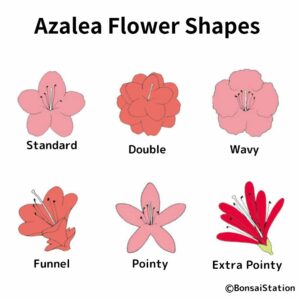
Azalea flower shapes
Azalea flowers come in a wide variety of forms.
- The most common azalea is tubular-shaped with five petals but some have more than 5 petals.
- The petals are usually lined up without overlapping, but some have double funnel-shaped flowers, and others have overlapping petals.
- The shape of the petals is usually oval, but some have wavy edges or degenerated, very slim and pointy petals.
Azalea flower color and color pattern
Color
Azaleas have a wide variety of color patterns but many of the flower colors are composed of combinations of red, blue, yellow, and white, such as pale red, reddish purple, pink, wisteria purple, bluish white, and pure white.
Color pattern
There are numerous color patterns; a single color, white inside and another color around the edges, white peripheral around the edges, two or more colors on a single flower, countless small spots on the entire petals, and irregular white patterns of various sizes on the petals.
Azalea leaf shape and color
Shape
Azalea leaves are usually a football-like shape with pointed tips and no jagged edges. Some have wider leaves with rounded tips, long, narrow leaves, or twisted leaves.
Color
The color of the azalea leaves is bluish green or reddish purple. There are some that have white/ yellowish white spots as well.
Azaleas for bonsai
Suitable characteristics for azalea bonsai
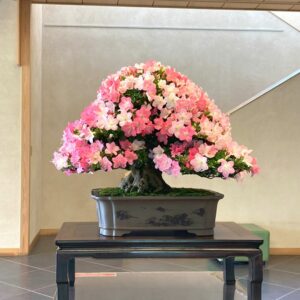
Azalea bonsai
While there is an uncountable number of azalea cultivars, not all are suited for bonsai cultivation. Among many azaleas, the following characteristics make a good azalea bonsai.
- Compact growth habit
- Small leaf size
- Beautiful flowers
- Thick trunks
- Fine and dense foliage
- Abundant flowering
Compact growth habit
Among the azalea family, some azalea varieties such as Satsuki azalea exhibit a naturally compact growth habit. This characteristic makes them well-suited for bonsai cultivation as they are easier to maintain small in tiny bonsai pots.
Small leaf size
Azaleas with small leaves are preferred for bonsai, as they maintain the proper proportion and scale when reduced in size for the miniature tree.
Beautiful flowers
One of the key features of azalea bonsai is its stunning flowers, and selecting varieties with particularly beautiful blooms that you like enhances the visual appeal as a bonsai.
Thick trunks
Bonsai trees benefit from having well-developed, thick trunks, as they convey a sense of age and strength. Azaleas that naturally grow thicker stems provide a solid foundation for bonsai styling.
Fine and dense foliage
A bonsai’s beauty lies in the intricate and fine branching structure. Azaleas that naturally produce dense and delicate branches are desirable for creating a balanced and visually appealing bonsai design.
Abundant flowering
For azalea bonsai whose beauty lies in its flowers, species/cultivars that produce an abundance of flowers during the blooming season are highly desirable.
Ideal azalea varieties for bonsai
Based on the preferred characteristics of azalea bonsai, which are compact growth habit, small leaf size, beautiful flowers, thick trunks, fine and dense foliage and abundant flowering, here are some ideal azalea varieties for bonsai cultivation.
Satsuki azaleas (Rhododendron indicum)

Satsuki azalea
Satsuki azalea (Rhododendron indicum) is an evergreen shrub native to Japan, often found growing on rocky surfaces deep in the mountains. It is one of the most popular species for bonsai cultivation.
It is a small shrub with a mature size of about 2 to 3 feet in both height and width. It has a horizontal growth habit; in the wild, it often grows with its roots attached to rocks along mountain streams, staying low to avoid being submerged during high water levels.
The leaves are small and hard compared to other azaleas, measuring about 1 inch (3cm) long.
Satsuki azalea is highly valued for its beautiful flowers and resistance to hard pruning. It is cold-tolerant and easy to cultivate as well, which has led to the development of numerous cultivars.
The name “Satsuki” comes from “May” in the Japanese lunar calendar (Satsuki), from its blooming time, typically from May to June.
Miyama Kirishima azaleas (Rhododendron kiusianum var. kiusianum)

Miyama Kirishima azalea
Miyama Kirishima Azalea (Rhododendron kiusianum var. kiusianum) is a semi-deciduous shrub native to Kyushu, the southernmost of Japan’s four main islands, and one of the common bonsai species.
Since it naturally grows in barren volcanic lands, its height reaches only about 3 to 6 feet (1 to 2 meters) tall. Its branches have a unique growth pattern, growing horizontally or slanting downward, not vertically, with a dense branching structure. The leaves are small, measuring 1/3 to 3/4 inches (8-20 mm) in length and long oval in shape.
The original flower color is reddish-purple, but there is a variety of shades, and some naturally bloom in white as well.
The name “Miyama” originates from the Japanese word “miyama”, which means “deep mountain” after its native habitat in mountainous regions. And the word “Kirishima” refers to the Kirishima Mountain Range, which is a volcanic mountain range located in Kyushu region.
Kurume azaleas
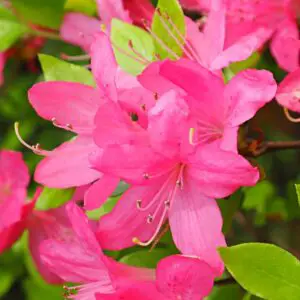
Kurume azalea
Kurume azaleas are another excellent option for bonsai. Kurume azaleas are a cultivar of Kirishima azalea that is said to have been produced about 200 years ago in Kurume region, Japan. The most distinctive feature of Kurume azalea is its flowers.
People have been breeding it for the past 200 years to make its flowers abundant and diverse in shape, size, and color. Some of the cultivars have pointed petal tips, while others have wavy folds around the petals. The colors can be white, red, pink, purple, and bluish-white, with many shades in between.
There are over 300 different kinds of Kurume azaleas, but not all of them are good for bonsai. Some have been specially improved for planting in gardens and not for bonsai.
Yama Tsutsuji/ torch azalea (Rhododendron kaempferi)

Yama Tsutsuji (torch azalea)
Yama Tsutsuji or torch azalea (Rhododendron kaempferi) is a semi-deciduous shrub that can reach a height of 3 to 13 feet (1-4 meters). It is one of the most common wild azalea species in Japan and has the widest distribution among them.
The leaves are small (1-3 mm long), growing in alternate patterns. They come in various shapes, including oval, ovate, elliptical, and oblong. The flowers display a range of colors, such as red, vermilion red, magenta, dark and pale shades, and occasionally white. There are also dark spots on the upper inner surface of the corolla.
No. of Satsuki azalea cultivars for bonsai
Satsuki Azalea (Rhododendron indicum) is a species in the subgenus Tsutsusi under the genus Rhododendron according to the American Rhododendron Society∗.
∗The Rhododendron family is said to have over 1000 species but estimates vary from 850 to 1200 species, suggesting its diversity. As such, the classification of Satsuki Azalea may be different in other taxonomy.
There are currently over 2000 registered Satsuki azalea cultivars for bonsai, with dozens of new ones registered every year. Apart from its beautiful flowers, there is another reason for such a huge number of cultivars being made; Satsuki azaleas tend to mutate quickly in a natural way and exhibit genetic diversity within the species.
It is quite common to see a branch on a Satsuki azalea tree suddenly produces different flowers (color, shape, pattern) than the rest of the tree. Sometimes, Satsuki azaleas grown from seeds can have flowers that look completely different from their parent tree.
This natural mutation provides a foundation for breeders to select and develop new cultivars with specific characteristics. By cross-breeding different Satsuki azalea varieties, breeders can create hybrids that combine desired traits, resulting in an even greater variety of cultivars.
How to identify Satsuki azalea and regular azalea
While Satsuki azaleas and regular azaleas∗ belong to the broader category of azaleas, there are some differences between them.
∗ Satsuki azalea=Rhododendron indicum); regular azalea= Miyama Kirishima azalea (Rhododendron kiusianum var. kiusianum)
Here are a few key points of comparison.
| Characteristics | Satsuki azalea | Regular azalea |
| Flowering Time | May to June | April to May |
| Blooming pattern | Blooms gradually over several weeks | Bloom at once |
| New shoots at bloom | Present | Not yet |
| Number of stamens | 5 | More than 5 |
| Leaf size | Small | Larger |
| Growth habitat | Horizontal | Horizontal/vertical |
Please note that the table above shows the typical differences between Satsuki azalea and regular azalea and their characteristics may vary a lot depending on the vast number of cultivars in the market.
To accurately identify what azalea cultivar you have, it is essential to rely on tags or labels and look for information from books or experts. You can also consult with staff at reputable nurseries or gardening stores.
Flowering Time
Satsuki azaleas bloom from May to June. Regular azaleas usually appear about a month earlier than Satsuki azaleas, specifically around April.
Blooming pattern
Satsuki Azaleas have a more extended blooming period compared to regular azaleas. They typically flower gradually over several weeks.
Regular azaleas, on the other hand, have a more synchronized blooming pattern.
New shoots at bloom
During its blooming period, Satsuki azalea already has new shoots simultaneously with its flowers. In contrast, regular azaleas typically do not have new shoots at the same time as its blooming.
Number of stems
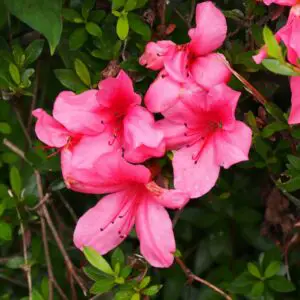
Satsuki azalea stamens (5)
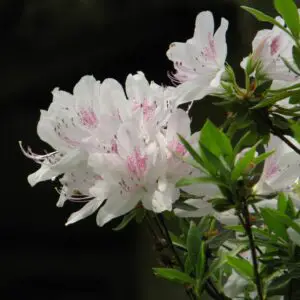
Regular azalea stamens (more than 5)
Satsuki azalea typically has 5 stamens while regular azaleas have more than 5 stamens.
Leaf size
Satsuki azalea typically has smaller leaves while regular azaleas have relatively larger leaves.
Growth habitat
Satsuki azalea typically grows horizontally. While regular azaleas grow horizontally as well, some can grow vertically.




